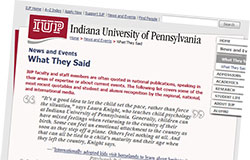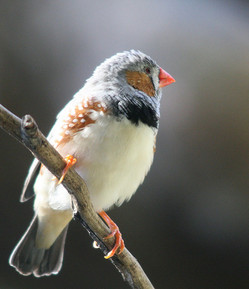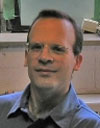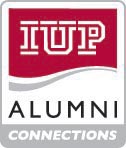 I am old enough to remember the celebration surrounding America’s first lunar mission and Neil Armstrong walking on the moon. (“One small step for mankind” is part of my heritage.) I also remember the ORIGINAL Apollo 13 mission (not just the movie with Tom Hanks), and I was one of the many people who were extremely impressed to have former astronaut Jim Lovell here at IUP for the First Commonwealth Lecture Series. To my generation, astronauts like the late Patricia Hilliard Robertson (a 1985 IUP Biology graduate) are heros, and space travel and NASA still have a major wow factor.
I am old enough to remember the celebration surrounding America’s first lunar mission and Neil Armstrong walking on the moon. (“One small step for mankind” is part of my heritage.) I also remember the ORIGINAL Apollo 13 mission (not just the movie with Tom Hanks), and I was one of the many people who were extremely impressed to have former astronaut Jim Lovell here at IUP for the First Commonwealth Lecture Series. To my generation, astronauts like the late Patricia Hilliard Robertson (a 1985 IUP Biology graduate) are heros, and space travel and NASA still have a major wow factor.
I also remember Skylab and how worried everyone was about the possibility of being hit by space junk falling from the sky. It did sort of tarnish the space program for me, mostly because it was such fodder for late-night comedians and the show Northern Exposure. (Who else remembers that was how Maggie O’Connell’s first boyfriend died?)
Fast forward thirty-two years, and here were are again. “Satellite the size of a school bus poised to fall to Earth at an undisclosed location,” television news reporters state with the appropriate look of concern. But I think Americans have a lot less panic and a lot more amusement over this satellite than Skylab.
 I know what I think, but I’m more interested in what our faculty experts have to say about current issues. Kenneth Coles, associate professor of Geoscience, did not disappoint on the subject of NASA’s UARS satellite and the “threat” of it hitting something–or someone–here on Earth.
I know what I think, but I’m more interested in what our faculty experts have to say about current issues. Kenneth Coles, associate professor of Geoscience, did not disappoint on the subject of NASA’s UARS satellite and the “threat” of it hitting something–or someone–here on Earth.
“Thousands of old satellites, rocket boosters, and pieces of debris orbit the Earth. Many are in orbits that eventually decay due to friction with the very thin uppermost atmosphere,” he explained.
“When they lose enough energy to fall to Earth, smaller objects burn up in the
atmosphere, but very large ones can make it to the ground. NASA and NORAD (the North American Aerospace Defense Command) track a lot of ‘space junk’ and give as much warning as practical of such events.
“Compared to the other perils of everyday life (such as riding in a car) the hazard is very minor for us on the ground, but space junk is a much greater problem in orbit, where collisions can cause considerable damage to a satellite or spacecraft.”
Even NASA experts are pretty calm about the possibility that you could be hurt by a falling piece of satellite. They predict that twenty-six parts of the satellite will survive re-entry into the Earth’s atmosphere, and the odds of getting hit by one of those pieces is 1 in 3,200.
So, while I am not a statistics expert, considering that Pittsburgh has an average of 152 snowy or rainy days each year, maybe I should do my own television news story: “This just in: Residents of Western Pennsylvania have a 41 percent chance of getting wet from snow or rain on any given day!”
Wonder if that will make Good Morning America? I’m ready for my closeup. …



 Dr. Nealen says that songbirds learn to vocalize or sing in a way that matches how humans learn to speak–by hearing themselves practice. In humans, hearing our own speech helps us to produce normal speech. Just ask any parent about that–it’s what we do to help our babies learn to talk.
Dr. Nealen says that songbirds learn to vocalize or sing in a way that matches how humans learn to speak–by hearing themselves practice. In humans, hearing our own speech helps us to produce normal speech. Just ask any parent about that–it’s what we do to help our babies learn to talk. Some say who you know is as important as what you know. If that’s true, what do you do when you don’t know someone? My colleagues in the
Some say who you know is as important as what you know. If that’s true, what do you do when you don’t know someone? My colleagues in the 